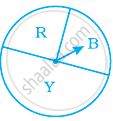Advertisements
Advertisements
Question
A die is thrown. Find the probability of getting:
2 or 4
Solution
\[\text{ When a die is thrown, the possible outcomes are 1, 2, 3, 4, 5 and 6 } . \]
\[\text{ Thus, the sample space will be as follows }: \]
\[S = \left\{ 1, 2, 3, 4, 5, 6 \right\}\]
\[\text{ Let A be the event of getting a two or four } . \]
\[\text{ Two or four occurs once in a single roll }. \]
\[\text{ Therefore, the total number of favourable outcomes is 2 }. \]
\[\text{ Hence, the probability of getting 2 or 4 is as follows }: \]
\[P\left( A \right) = \frac{2}{6} = \frac{1}{3}\]
APPEARS IN
RELATED QUESTIONS
In a simultaneous throw of a pair of dice, find the probability of getting:
a doublet
In a simultaneous throw of a pair of dice, find the probability of getting:
a number other than 5 on any dice.
A card is drawn at random from a pack of 52 cards. Find the probability that the card drawn is:
black and a king
A card is drawn at random from a pack of 52 cards. Find the probability that the card drawn is:
neither an ace nor a king
A card is drawn at random from a pack of 52 cards. Find the probability that the card drawn is:
jack
A card is drawn at random from a pack of 52 cards. Find the probability that the card drawn is:
a heart
A card is drawn at random from a pack of 52 cards. Find the probability that the card drawn is:
a red card
It is impossible to get a sum of 14 of the numbers on both dice when a pair of dice is thrown together.
The probability of getting an ace out of a deck of cards is greater than 1.
When a spinner with three colours (Figure) is rotated, which colour has more chance to show up with arrow than the others?

